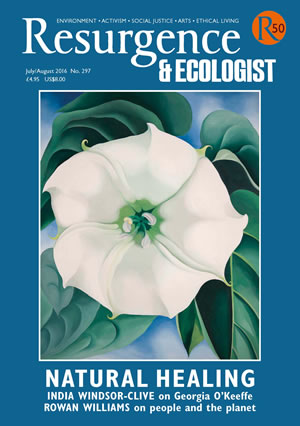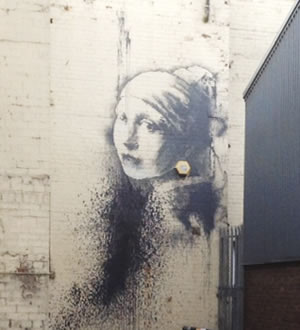In the autumn of 2014, the elusive graffiti artist Banksy recreated Vermeer’s Girl with a Pearl Earring high on a wall in Bristol’s dockland, larger than life, and incorporating a yellow fire alarm as the young woman’s ‘pearl’. Hidden between two warehouses, the Girl looks out from her secret corner upon the other hidden pearl of this once forgotten industrial quarter: Studio Upstairs.
Studio Upstairs is an organisation providing unique therapeutic art studios in London and Bristol. The first was set up in 1988 in a squat in Diorama Arts, Regent’s Park, London by three dynamic people with diverse backgrounds in the arts, performance, teaching and psychotherapy Douglas Gill, Claire Manson and Jo Hill.
The trio regarded Diorama Arts as an excellent environment in which to develop the project, which was radically different from any psychiatric services then available. The motivation for starting the studio had come from the founders’ frustration with their work in traditional art therapy practice, where art was produced for its interpretive value and then kept filed away. They wanted to create a culture where art was not seen as a recreational pastime but as a serious objective in its own right that could appear in the public gallery.
More importantly, they recognised the need for people to move away from the psychiatric system. Whilst too vulnerable to attend adult education, members of the studio had the opportunity to create art away from the clinical setting.
As a result of interest by the art therapy profession in Bristol, the second Studio Upstairs was opened in January 2000 Spike Island, the city’s international centre for contemporary art and design, with some painting resources and one volunteer artist. It opened one day a week and supported two members. From then the membership gradually grew, along with the number of artist volunteers and art therapists. Working partnerships developed with a number of arts, health and educational organisations.
The project has proved increasingly resilient, despite public spending cuts. In May, a new Studio Upstairs was opened in Croydon, South London. “We believe in artistic practice as a valuable way to create meaning and purpose in life,” says Zlatinka Hristova, the organisation’s director. “After a few really challenging years, Studio Upstairs has weathered the storm and not only survived, but flourished and is growing.”
Following on from the ideas of R.D. Laing – who believed in talking rather than medication – a non-medical model for psychosis and mental distress – Studio Upstairs encourages its members to come into a community with like-minded people, using creative expression to transform their lives. Artist members and art therapists make art together and talk. They talk about art and materials and, if the time and space are right, about unspoken feelings of piercing pain and suffering.
In Studio Upstairs tradition, the members, volunteers and art therapists of the Bristol studio work alongside one another. Studio managers are named as such, rather than ‘staff’ or ‘therapist’, in the spirit of attempting to deconstruct the fixed roles people often find themselves in. This methodology is especially significant when people are subjected to an external diagnosis.
I had a studio in Spike Island when Studio Upstairs first came to my attention. I had recently been bereaved, and in conversation with an art therapist friend, I discovered there was a therapeutic studio on the top floor of our building. I became involved and joined as a volunteer artist. The place was perfect. I found somewhere I felt safe with my own chaotic feelings, as well as an abundance of materials and an open philosophy about framing art within life. The Studio held Open Weekends at the same time as the Spike Open, and ran workshops and residencies for visiting artists. It also acquired another space in the Spike building for a “moving on studio”, where artists could progress with their art in their own time with support from the Studio if needed.
I stayed in Studio Upstairs for 10 years. During this time I saw members go on to take degrees, become art therapists, teachers, writers and poets, and become more confident in the wider community. I saw others who were kept out of hospital as a result of the commitment of the Studio to giving psychological support when needed.
During Studio Upstairs Bristol’s time on the top floor, its membership grew and grew. With its success it was obvious that it needed larger premises, and so in 2003 it moved to its current home, an industrial unit, light and spacious, encouraging the possibility of making larger work in 2D and 3D.
Underpinning the therapeutic practice at Studio Upstairs is the idea of ‘dwelling’. Being able to dwell, according to Heidegger, is a process of forgetting oneself, losing one’s self-consciousness, in a ‘safe’ place. Being at home, belonging, is to be oneself.
For nearly 20 years, Studio Upstairs Bristol has served all those looking for a therapeutic space in which to make art. Members, volunteers and art therapists come to the Studio from all parts of the west of England and Wales, and most memberships are supported by welfare benefits. It has become a place to form friendships and find confidence in a creative life; a place where people can think and speak – aesthetically, emotionally, socially – or remain silent; a place whose very being is synonymous with healing; a place where mental illness is seen as ordinary through the extraordinariness of art.
Studio Upstairs continues to make the case that art is intrinsic to a healthy life. In these difficult times, Banksy’s yellow pearl alarm serves as a warning: life without art is madness.
THREE STUDIO STORIES
‘I am a professionally trained fashion and textile designer. My career came crashing to a halt with the birth of our disabled child, the subsequent onset of my own physical disabilities and the end of my marriage. Since I became a self-funding member of Studio Upstairs (as my local health authority will not fund me) it has become an essential retreat and sanctuary, which offers me much-needed respite from my ongoing caring duties.
Studio Upstairs has supported me to re-engage with my creative self. This process has been deeply satisfying: drawing is again like breathing, and I feel whole again.’
‘I arrived at Studio Upstairs having recently completed a home detox, with no medication or assistance. The day before I arrived to have a look around was the first time I had walked in over a week. What I needed was a place to just be, and whilst in this state of being I could do something that I really loved, to draw and paint and take time to understand the last year, the havoc I had wreaked and a family meltdown.
After six months I am now back in employment and have moved to my own studio space. This is down to many factors, foremost that of Studio Upstairs.’
‘My work explores relationships and the formation and maintenance of identity, through the making of masks, and their usage in film and performance. Having attended Studio Upstairs for about 10 years, I learned to dissociate myself from the label attached to my illness and focus on the narrative aspect of my work.’








